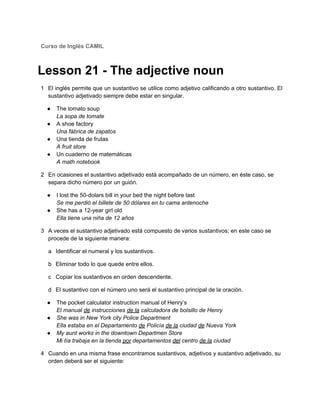
Aprende a usar sustantivos como adjetivos en inglés
- 1. Curso de Inglés CAMIL Lesson 21 - The adjective noun 1 El inglés permite que un sustantivo se utilice como adjetivo calificando a otro sustantivo. El sustantivo adjetivado siempre debe estar en singular. ● The tomato soup La sopa de tomate ● A shoe factory Una fábrica de zapatos ● Una tienda de frutas A fruit store ● Un cuaderno de matemáticas A math notebook 2 En ocasiones el sustantivo adjetivado está acompañado de un número, en éste caso, se separa dicho número por un guión. ● I lost the 50-dolars bill in your bed the night before last Se me perdió el billete de 50 dólares en tu cama antenoche ● She has a 12-year girl old Ella tiene una niña de 12 años 3 A veces el sustantivo adjetivado está compuesto de varios sustantivos; en este caso se procede de la siguiente manera: a Identificar el numeral y los sustantivos. b Eliminar todo lo que quede entre ellos. c Copiar los sustantivos en orden descendente. d El sustantivo con el número uno será el sustantivo principal de la oración. ● The pocket calculator instruction manual of Henry’s El manual de instrucciones de la calculadora de bolsillo de Henry ● She was in New York city Police Department Ella estaba en el Departamento de Policía de la ciudad de Nueva York ● My aunt works in the downtown Departmen Store Mi tía trabaja en la tienda por departamentos del centro de la ciudad 4 Cuando en una misma frase encontramos sustantivos, adjetivos y sustantivo adjetivado, su orden deberá ser el siguiente:
- 2. [Adjetivo] + [Sustantivo adjetivado] + [Sustantivo principal] ● Your new blue evening dress is dirty Tu nuevo vestido azul de noche está sucio Nota: El orden de los adjetivos es: 1 Determinante (my-your-this) 2 Cualidad (beatiful-ugly-pretty) 3 Tamaño (big-large-small) 4 Antigüedad (new-old-modern) 5 Forma (square-round) 6 Color (red-blue-yellow) 7 Origen (mexican-russian) 8 Material (metal-plastic) 9 Propósito (cleaning-winter) 5 No debemos confundir ciertas palabras que aparentemente están escritas en plural; en realidad se trata de unas unos sustantivos que no tienen ninguna relación con algunos adjetivos. New (nuevo) News (noticias) Good (bueno) Goods (mercancías) Blue (azul) Blues (género musical) Green (verde) Greens (verduras) Nota: Las siguientes palabras no pierden la “s” aunque se les aplique el sustantivo adjetivado. Custom officer Oficial de aduana Savings account Cuenta de ahorros Salesman / woman Vendedor (a) Sportsman / woman Deportista
